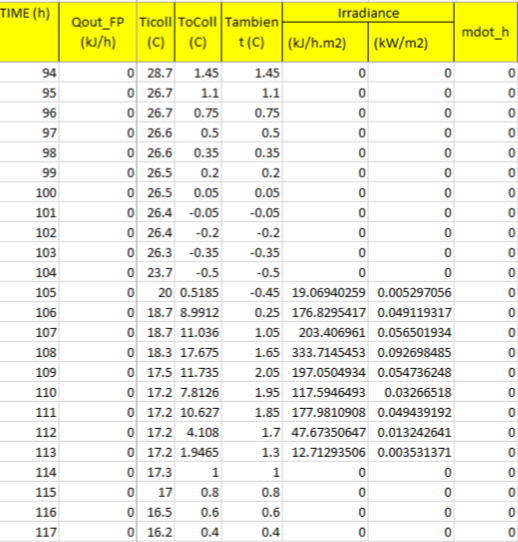<Why the outlet temperature of solar collector (type 1b) same as temperature ambient when there is no mass flow rate and irradiance. As you can see in the table below, ToColl = Tambient)
If you leave water inside a solar collector and there is no radiation incident upon the surface and no water flow, it will quickly degrade towards the ambient temperature. Type1b has no mass (unlike the Tess Type 539) so it immediately decays to the ambient temperature.
<How TRNSYS calculate the outlet temperature of the solar collector if there is no mass flow rate, but only the irradiance available?>
It solves the same energy balance as it does when there is flow. The no-flow solution is found when the solar gains match the thermal losses from the collector (absorbed energy = losses).
Jeff
---
Jeff Thornton President - TESS LLC 22 N. Carroll Street, Madison WI USA 53703 Office: (608) 274-2577 Fax: (608) 278-1475 www.tess-inc.com E-Mail: thornton@tess-inc.comOn 06/06/2017 9:09 am, Rm Chemilo via TRNSYS-users wrote:
Dear all,I want to ask several questions about TRNSYS example solar domestic hot water (SDHW).- Why the outlet temperature of solar collector (type 1b) same as temperature ambient when there is no mass flow rate and irradiance. As you can see in the table below, ToColl = Tambient.- How TRNSYS calculate the outlet temperature of the solar collector if there is no mass flow rate, but only the irradiance available?Thanks._______________________________________________ TRNSYS-users mailing list TRNSYS-users@lists.onebuilding.org http://lists.onebuilding.org/listinfo.cgi/trnsys-users-onebuilding.org
_______________________________________________
TRNSYS-users mailing list
TRNSYS-users@lists.onebuilding.org
http://lists.onebuilding.org/listinfo.cgi/trnsys-users-onebuilding.org
